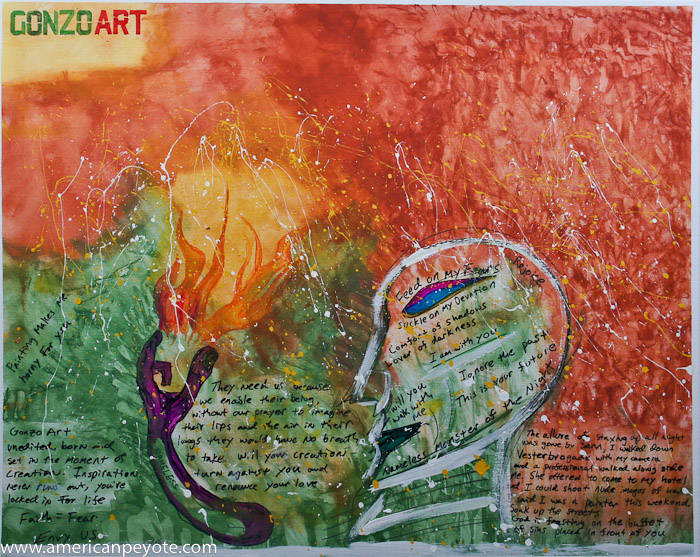 The first rough cut from my video poetry collaboration with DJ Cue is up. The music was composed by DJ Cue (Bobby Cuevas) while I provided the visuals and recorded ambient audio. This was made possible thanks to Talenthouse.com and their Creative Invite collaboration platform. This is a rough cut, so it doesn’t include the poetry dialogue that I will eventually add (actually, I’m looking for a woman with a nice classic German accent to do some voice recording), but it’s a nice visual representation of what I’m trying to create. Video imagery includes the abandoned Bärenquell Brauerei in East Berlin, Barbara running through Zurich Bahnhofstrasse (shoot organized with Ethan Oelman), and also a quick look from a underground club night in Berlin, part of an Alternative Berlin night tour I did in the city. Thanks to everyone involved, now that I’ve setup my computers in my new apartment I can get back to shooting and creating on a more normal basis. Enjoy…
The first rough cut from my video poetry collaboration with DJ Cue is up. The music was composed by DJ Cue (Bobby Cuevas) while I provided the visuals and recorded ambient audio. This was made possible thanks to Talenthouse.com and their Creative Invite collaboration platform. This is a rough cut, so it doesn’t include the poetry dialogue that I will eventually add (actually, I’m looking for a woman with a nice classic German accent to do some voice recording), but it’s a nice visual representation of what I’m trying to create. Video imagery includes the abandoned Bärenquell Brauerei in East Berlin, Barbara running through Zurich Bahnhofstrasse (shoot organized with Ethan Oelman), and also a quick look from a underground club night in Berlin, part of an Alternative Berlin night tour I did in the city. Thanks to everyone involved, now that I’ve setup my computers in my new apartment I can get back to shooting and creating on a more normal basis. Enjoy…
Video
Video Poetry Pre-Production
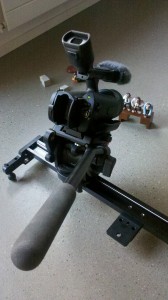 The video poetry project is in full pre-production chaos, perfect time to give an update on the process. I’ve been pulling ideas from the back reaches of my brain, shooting video, writing poetry, and listening to music from DJCue, all in an effort to build up the video poetry project. Here’s a breakdown of the pre-production journey so far, but first a recap. In July DJCue won the video poetry CreativeInvite contest on Talenthouse, where people submitted music and I picked one to work with. The goal of our collaboration is to create some original short films using his music and my video. How it has come together so far…
The video poetry project is in full pre-production chaos, perfect time to give an update on the process. I’ve been pulling ideas from the back reaches of my brain, shooting video, writing poetry, and listening to music from DJCue, all in an effort to build up the video poetry project. Here’s a breakdown of the pre-production journey so far, but first a recap. In July DJCue won the video poetry CreativeInvite contest on Talenthouse, where people submitted music and I picked one to work with. The goal of our collaboration is to create some original short films using his music and my video. How it has come together so far…
The Theme
The theme is as abstract as ever, and I want to pull together the main components together and produce some magic (I know, that sounds like a load of abstract bullshit). This allows me to start from a few different directions. For example, write a poem and try to storyboard a film from it, shoot random film footage and cut it to music and then add poetry, any variation of the two and everything in between. The reason I’m making this seem so chaotic is that I’m still experimenting with the video poetry work flow, and as it is when I stare down a blank canvas, I’m a little freaked out it will all suck in the end. I see video poetry as a format in between the Art Film and the Short Film.
In an art film you try to communicate some abstract concept without dialogue, and the result generally loops on a monitor in a gallery or installation somewhere (that you need to watch looping for two hours before you get a sense that you might perhaps – sort of, will eventually figure out what the fuck it is about). In contrast, the short film communicates a story in a compact timeline, but is more likely to include traditional elements like a script, shot list, planning, etc. What I want to do here is to have a combination of the two, communicate an abstract concept as you might find in my mind and the traditional film workflow (as I learned it from Vincent LaForet on CreativeLive). This is more inline with how I create images in Photoshop or painting, where I begin with a base image or idea and then build around and layer it, the result being something I didn’t necessarily plan for from the beginning. The elements we have to mix and layer are music (from DJCue), poetry, and video.
Music
The beauty of the video project is that DJCue handles the music production and I focus only the on video and poetry. Spinning in his bedroom/studio he mixes up productions for SoundCloud, Restorm and any manner of use in life in between. This adds a certain dynamic to the workflow, I don’t know exactly what he has in mind, he just creates stuff and sends it over, this challenges me to create poetry and video mixes which build on and complement his music. Check out his stuff on SoundCloud, Twitter (@therealdjcue), Talenthouse, and his blog.
 Poetry
Poetry
This is probably the most difficult part (aside from finalizing the final edit of the film). I hear music in my head, remixes of stuff from my past and I get inspiration to put words together, ending up in what you might call poetry or spoken word. But the words sometimes have a tempo of their own, and don’t always mix so well with music when I try to put them together later on. Visual imagery also has it’s own tempo, and if you start by just shooting from a story board, chances are you won’t end up with the right mix between the music and the words, I guess this is the conundrum from whence the profession of film editor arose from. My feeling is that it’s best to start with the visual arrangement in flexible blocks (let’s call them mini scenes) and then add the audio in the studio after adding in the soundtrack.
Tools
For video, we need tools. Tools include, my Sony NEX VG10 camera, audio via a Zoom H4, various lenses, and a Jag35 Field runner rig. Now that I have some ideas in my mind for other shots I realize I need a slider, or linear motion control device (to move the camera on a set of rails). I picked up an Atlas FLT, which will be needed when I head to Berlin.
 Location Berlin
Location Berlin
I like the concept of the urban landscape, and now that video is part of the equation, it makes sense to put together some footage in one of my favorite cities, Berlin – where I’ve much writing you could call poetry. I haven’t been there since 2010 when I visited the UXcamp. The idea this time is to go back for the Google Developer day and take a few days to shoot around the city with my VG10 and an Atlas FLT slider. Where? There are a number of options. My first goal is heading back to Beelitz, an abandoned hospital complex south of the city. Goal two, the Teufel-berg in the former West sector. Goal three…there’s too many goals to list in a place like Berlin.
I shot for a day in Beelitz in 2010, and fell in love with the place like most people do when they visit. The hospital was established in the late 1800’s and was taken over by the Russians after Berlin was taken in 1945. If you venture through the corridors you’ll still find Russian articles all over the place. It’s probably the most popular urbex location in Germany, on par with the Packard plant in Detroit, Michigan. Unlike the Packard plant, parts of Beelitz are being renovated, meaning parts are no longer accessible. However, the main surgery building was still open in 2010, and I want to get back there and shoot before it’s gone. The inside of the buildings are covered with grafitti, and all manner of creepy writings that will freak you out when the wind slams a door closed as you walk the corridors alone. Rumor has it however, well, not rumor but more fact, that some one died in Beelitz while exploring the ruins around 2010, and now the place is guarded, also to avoid further vandalism from hooligans haunting the forest.
The Teufelsberg translates directly as Devil Mountain. After the war Berlin needed to be rebuilt, and all of the trash, broken buildings and such were piled on top of one another and eventually the Teufelberg was formed. During the Cold War the NSA built a monitoring station there to snoop on the East, and the building with funky octadome radio installation is still standing. It’s unclear how open it will be here, but internet recon suggests it should be accessible, I may however defer to other places if it doesn’t work out.
Location Zurich
It’s always good to team up with other creative folks on projects, and my main collaborator in Zurich is the photographer Ethan Oelman. We do projects together where he focused on photography and I focus on video, and then I mix the two together in a short video, our last finished collaboration was the video Dancing with Water. Lately we met up in downtown Zurich with a Med-student-model he works with. I took footage of her before the sun went down, and then I assisted Ethan as a light man, walking around with a softbox on a boom while he did the shooting.
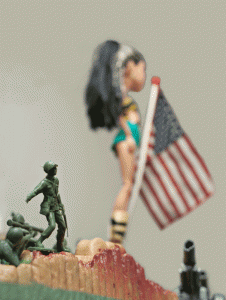 Animation Experimentation
Animation Experimentation
Many times when I’m shooting still images I have a short movie playing in my head. The Bratz image series in particular is something I always wanted to animate, to have the scene include some elements of interaction. Now that I’m picked up Photoshop CS5 this is a realistic project. How it will fit into the poetry concept I’m still debating in my heads, but the potential is there to create some active elements that work into the shot video of the project. I started out with a simple Toy Wars image with some plastic Army Men and Cleo de Nile from Monster Highschool. Using the Puppet Warp tool in Photoshop I did some masking and warping to create a few animation frames of the American flag waving in the wind. Then I’ll scale that up to animating the sergeant and background elements (still to be imagined).
Bringing it All Together
So, that’s the plan. Shots form Zurich and Berlin, likely mixed up with strange animations of Bratz dolls and and Army Men battling in a new world apocalypse landscape.
Winner Announcement: Video Poetry Project
 The grand video poetry creative invite experiment is going to the next level. I am pleased to announce that Bobby Cuevas is the winner. There were 15 entries from artists in different corners of the world submitting to the contest, and I had the opportunity to pick one to work with. Thank to everyone who submitted to the contest, it was truly an honor to see people creating music for the project, and using Talenthouse to connect us was excellent. The winner of the contest has the opportunity to work together with me on my next series of video poetry short films. I’ve never been in the position of choosing a contest winner, and in the end the choice was made on context.
The grand video poetry creative invite experiment is going to the next level. I am pleased to announce that Bobby Cuevas is the winner. There were 15 entries from artists in different corners of the world submitting to the contest, and I had the opportunity to pick one to work with. Thank to everyone who submitted to the contest, it was truly an honor to see people creating music for the project, and using Talenthouse to connect us was excellent. The winner of the contest has the opportunity to work together with me on my next series of video poetry short films. I’ve never been in the position of choosing a contest winner, and in the end the choice was made on context.
Context
Judging creative work of others is a strange business, and in the end it comes down to tastes and context. There’s really no other honest way to do it. Something can be technically great but not be what you’re looking for. The context is the head of the person choosing, and isn’t something that can be predicted or necessarily designed for. This was one of the main lessons from the Professional Artists seminar I attended at the F&F Kunst schule in Zurich this summer. Art is bought in the gallery scene based on context. Is it new, does it fit with the gallery, is it maketable, does it create a reaction – and how does it do that in relaitonship to all the other art in the Zurich art world? Art doesn’t have value without context, and as the context changes, so does the value of the art.
Decisions Decisions
For the decision process, I mainly looked to see what the music would create in my head, and based off of how ambivalent or twisted those images were, I decided to go with that artist. I figured, the music which creates the strongest reaction in me is probably the best one to go with. This was a measure of how the work of the artists would match my work. There were a number of entries which were excellent, and I could imagine creating a movie with them, but just didn’t fit into the context of the project I have in my head. As an artist, the most important thing is to connect with people who like your work, that is the context in which you will be successful, and sometimes it just needs to be one or two people.
Bobby did a production called Coming Together, it starts with a cut from the song Come Together, and then drops into a drumming rhythm, it sort of bores into my head and remixing into a fluid menagerie that just mixes well with images of a Bratz doll 50 feet tall, walking through Detroit with a .50 Cal sniper rifle. It was the later part of the track that started pushing my neurons around. I could see a sort of blackness with interspiced flashes and a person walking down the street, the camera in my head did a pan and then a steadycam momevent around a guy’s face, then the scene was reversed in editing and then there was a robot fish crawling out of the ocean and started to walk.
So, I look forward to working with Bobby on a video poetry short film series. Thank you to Talenthouse, adambrioza, ybudman, lollyjean and everyone who submitted to the video poetry creative invite.
Bobby Cuevas
Work With Me on a Video Poetry Project
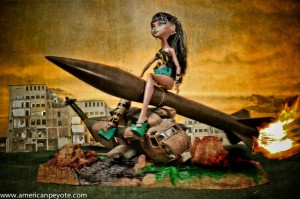 Something went live the other day, a fine determined attempt at creative collaboration on a global scale. It’s called, Collaborate on a Video Poetry Film Series. It’s a creative invite on Talenthouse.com, that fabulous website that connects creators together and is the current website to be on for interesting collaboration opportunities. Essentially I’m looking for a person to work with on a video poetry series. From my side, I’ll provide the visuals and words and you provide the soundtrack. I’ll mix everything together and we’ll ride the wave of internet propaganda to stardom together. On the creative invite page on Talenthouse is the inspiration. There’s a video of my latest still images, and the idea is that DJ’s, producers, etc. can be inspired by that to submit a track that fits to the images. I’ll pick the music submission that best fits in my brain and then we’ll collaborate together on a series of video poetry short films. It doesn’t matter who or where you are in the world, this is an opportunity to connect and work together across cultural, economic, societal and internet boundaries.
Something went live the other day, a fine determined attempt at creative collaboration on a global scale. It’s called, Collaborate on a Video Poetry Film Series. It’s a creative invite on Talenthouse.com, that fabulous website that connects creators together and is the current website to be on for interesting collaboration opportunities. Essentially I’m looking for a person to work with on a video poetry series. From my side, I’ll provide the visuals and words and you provide the soundtrack. I’ll mix everything together and we’ll ride the wave of internet propaganda to stardom together. On the creative invite page on Talenthouse is the inspiration. There’s a video of my latest still images, and the idea is that DJ’s, producers, etc. can be inspired by that to submit a track that fits to the images. I’ll pick the music submission that best fits in my brain and then we’ll collaborate together on a series of video poetry short films. It doesn’t matter who or where you are in the world, this is an opportunity to connect and work together across cultural, economic, societal and internet boundaries.
Where did the idea for this come from? It was a pretty organic evolution of the internet, inspiration, and motivation. In 2010 I submitted some paintings to a Talenthouse Creative Invite. I won the invite, and then participated at 1 Day of Art Copenhagen with (t)here magazine, then I printed a card of my best painting from Copenhagen and sent it to Jennifer Chalbaud in Venezuela who then had a dream inspired by my Gonzo Art and she created a cool design for Mambo Surf Deluxe. I wrote a blog post about it all and then Talenthouse contacted me, seeing if I would be interested in running a community creative invite. I said hell yes, and here we are.
I like painting because it’s the unknown. I never know what will come when I stare down that big white canvas, and I have no idea what will happen with this creative invite, but soon I’m going to find out. When I create I often think like a movie maker, I hear the music in my ears and break paintings up into little movies in my head. That’s why I’m excited about the possibilities of this opportunity. It’s the possibility of meeting someone motivated to create great music to mix well with the art I’m creating. In this context the idea of video peotry films is just natural for me, it’s the natural evolution of art and video. If you’re a music maker, please check out the creative invite, and you have my deepest gratitude if you pass the word on to anyone you know who might be interested. Click here to visit the page on Talenthouse.com, and below is a video explaining the idea.
and here is the inspiration…
Ethan Oelman – Dancing with Water Video
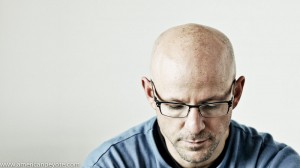 I first met Ethan at the Strobist CERN workshop a couple years ago. Since then we’ve both grown our photographic styles and meet up for a coffee in Zurich to bounce ideas off one another from time to time. I’ve been getting into video and short film production, and Ethan was interested in doing a video project on his work. So it was a natural thing to make a video together about his photography. The goal was to do a behind-the-scenes video during a shoot, and then bring that together with the story behind the images. After the Dancing with Water shoot, I dropped by his apartment and filmed him talking about his work and the images from the shoot. During the shoot I also shot some footage of one of the dancers, Alexa, coming in and out of the water and put together a shot film called Birth-Kraft. Basically I just took everything I learned from watching Vincent Laforet on his CreativeLive film workshop, and produced this short video of Ethan Oelman and his photographic vision.
I first met Ethan at the Strobist CERN workshop a couple years ago. Since then we’ve both grown our photographic styles and meet up for a coffee in Zurich to bounce ideas off one another from time to time. I’ve been getting into video and short film production, and Ethan was interested in doing a video project on his work. So it was a natural thing to make a video together about his photography. The goal was to do a behind-the-scenes video during a shoot, and then bring that together with the story behind the images. After the Dancing with Water shoot, I dropped by his apartment and filmed him talking about his work and the images from the shoot. During the shoot I also shot some footage of one of the dancers, Alexa, coming in and out of the water and put together a shot film called Birth-Kraft. Basically I just took everything I learned from watching Vincent Laforet on his CreativeLive film workshop, and produced this short video of Ethan Oelman and his photographic vision.
I had a wonderful time producing and shooting this video. I was getting intimidated a bit watching the CreativeLive workshop, but once you break things down to the essentials and put together the essentials of what you need for your project, all you need is to focus on your vision and forget about the rest. To see more of Ethan’s work, check out his website, Ethan Oelman Photography.
Tech Details
For those who are interested, the footage was shot with my Sony NEX-VG10, using a couple of different lenses including a Mamiya 645 80mm f/2.8 both on a tripod and using the Jag35 Field Runner rig. I used a Manfrotto 501 fluid head when on a tripod. The audio was recorded using an old Zoom H4 and was synced to the original footage using the Dual Eyes software. Everything was cut together in Final Cut. I’m looking forward to picking up a lapel microphone and also a shotgun mic to improve my audio gathering capabilities on future projects. The music is from Moby Gratis.
Experiments in Video Production
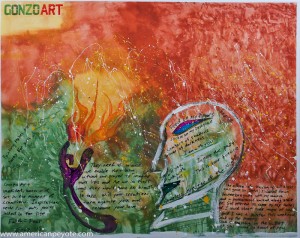 I’ve had an interesting trip the past two years. I started focusing on photography, turned to painting, and now I’m into the idea of mixing everything in video/film production. I like learning new things, it drives me in life to look back after a year after and see those interesting turning points where I learned something new about my position in life and those around me. In the past I did some experiments with Art Casting, making stop-motion videos of paintings as they’re painted to show the evolution of the work. After I participated in 1 Day of Art Copenhagen I realized there could be something more.
I’ve had an interesting trip the past two years. I started focusing on photography, turned to painting, and now I’m into the idea of mixing everything in video/film production. I like learning new things, it drives me in life to look back after a year after and see those interesting turning points where I learned something new about my position in life and those around me. In the past I did some experiments with Art Casting, making stop-motion videos of paintings as they’re painted to show the evolution of the work. After I participated in 1 Day of Art Copenhagen I realized there could be something more.
I wanted to create a video that brings together the thoughts in my head and the music that I feel as I paint. So after getting back from Copenhagen I picking up a Sony VG10, started watching the Vincent Laforet film class from CreativeLive, and began learning how to make short films. The first few so far are Birth – Kraft and Gonzo Art. The goal is just to make something, that is going in the right direction. I’m basically a self-learning film student at the moment, and my first goal is to get down the film production workflow and make 1-2 minute films with a message.
Birth – Kraft
Birth – Kraft is a collaboration with Ethan Oelman, a photographer in Zurich. He planned a shoot with a dancer and rented out a pool in Altstetten in Zurich. I came by with my VG10 to shoot footage for a behind-the-scenes video and also to experiment. I shot footage of the dancer coming out of the water and then cut that together with still images that Ethan made during the shoot. I used Abaltat Muse to make the soundtrack. The flow of the film and the transition between themes was my main focus. Abaltat is an interesting program for quickly cutting music for videos, but I need to energize some music skills into the workflow.
Gonzo Art
Gonzo Art is a video of my favorite painting from 1 Day of Art Copenhagen, made for (t)here magazine. It includes a lot of writing inspired by Copenhagen and has many visual elements like fire and a giant head. How do you capture the texture of a painting on video? How do the visual forms need to be presented? I don’t know exactly, and that’s why this is an experiment. I used Garageband with samples from Computer Music magazine to cut the music. I then added voice-over using a helium filter on my vocals in Garageband. The soundtrack sort of sucks, but it’s a starting point for moving forward. Video production is forming the motivation to develop my music creation abilities, something I always wanted to get into.
What’s Next
I don’t know the future, I just know the awesome feeling I have cutting visual and music elements together. It feels right and powerful in an intimate way. It’s important to look back on how you got where you are. This short Gonzo Art video started with Talenthouse and a Creative Invite. I submitted my Lazy Art paintings and (t)here magazine picked my work, allowing me to participate in 1 Day of Art Copenhagen. This opened up a turing point in my creative life, I realized the ability to create is there, it just needs the right motivations and environment. You excel when you have awesome people around you, chilling on your own behind a computer is a recipie for mediocracy. The internet and social media are awesome for connecting people to one another and to new ideas, but you need a healthy creative environment in you life.
Concept to Photo – Urban Dry Tooling Video Tutorial
 Photography and text-based web publishing are fantastic tools for communicating ideas across the world. However, they have their limitations. I think in a 3D moving picture mindset, and therefore, it made sense to start communicating using moving pictures and spoken words. Concept to Photo – Urban Dry Tooling is a video tutorial about starting with a concept, and then translating that inspiration into a final photo.
Photography and text-based web publishing are fantastic tools for communicating ideas across the world. However, they have their limitations. I think in a 3D moving picture mindset, and therefore, it made sense to start communicating using moving pictures and spoken words. Concept to Photo – Urban Dry Tooling is a video tutorial about starting with a concept, and then translating that inspiration into a final photo.
This isn’t a new idea, there are many photography related video tutorials on the web. However, I rarely find one I want to watch for more than 30 seconds, because they’re either boring, or filled with the least relevant information possible. Another problem is that in many ways the photography tutorial video genre has become a dumping ground for marketing videos from photographers trying to emulate Chase Jarvis – the famous commercial photographer from Seattle who is often credited with starting the photo-video marketing movement. However, he’s a unique gem in the chaotic video landscape of the internet, and his videos have yet to be matched for style or content. I’m not a photographer posting a video to show off my equipment and pretend like I have a cutting edge production studio. I’m a guy in an apartment with an old G4 Macintosh and an old Minolta 7D DSLR who likes to think up concepts and express them.
The concept behind this video is simple, compress my creative and photo production process into the upper attention span limit of an average internet video viewer.
This video tutorial was created to fulfill three functions: first, as an exercise for me in producing a video I would want to watch (but I’m weird so this probably doesn’t apply to the average internet viewer). Second to help me understand my creative workflow by packaging it in a video form (teaching to others is the best way to learn). And Third to give other photographers, creatives, and anyone else interested in a new (or old) perspective on the creative process as applied to photography.
Audio was recorded using my Zoom H4, screen capture video was obtained using Snapz Pro X, music was obtained from Kevin Mcleod’s music collection, and the rest is just still images and titles. Some say that soon cameras and camcorders will be one and the same, and they’re right. But in transitioning to the video world I wanted to start simple, and that meant using primarily still images.


